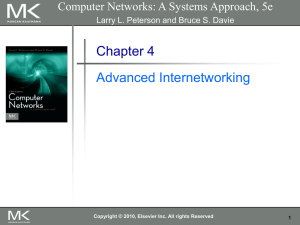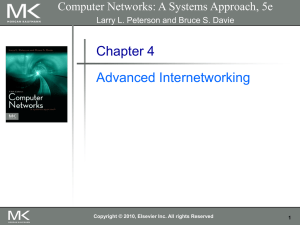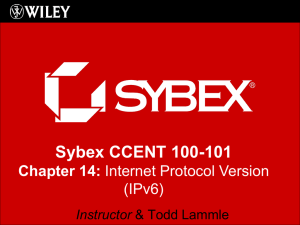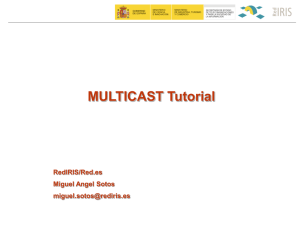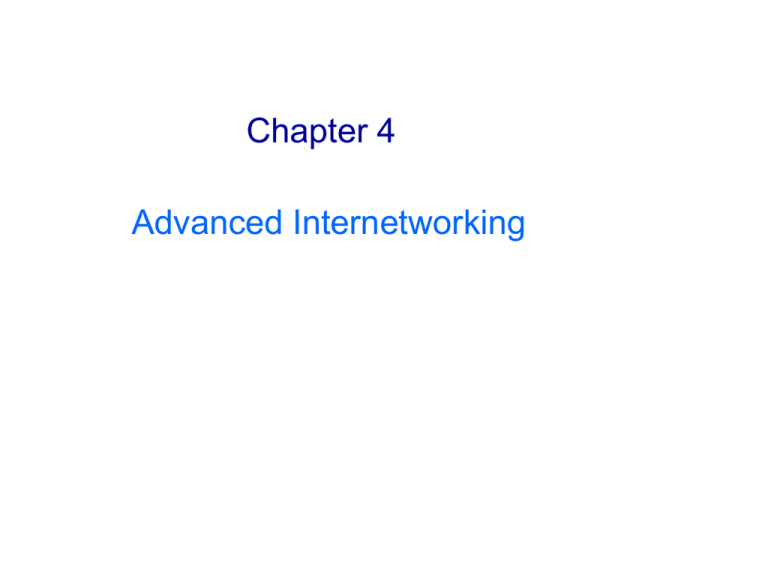
Chapter 4
Advanced Internetworking
Copyright © 2010, Elsevier Inc. All rights Reserved
Problems
How do we build a routing system that can
handle hundreds of thousands of networks and
billions of end nodes?
How to handle address space exhaustion of
IPV4?
How to enhance the functionalities of Internet?
Chapter Outline
Global Internet
Multicast
Mobile IP
Chapter Goal
Understanding the scalability of routing in the
Internet
Discussing IPv6
Understanding the concept of multicasting
Discussing Mobile IP
The Global Internet
The tree structure of the Internet in 1990
The Global Internet
A simple multi-provider Internet
The Global Internet
Interdomain Routing (BGP)
Internet is organized as autonomous systems
(AS) each of which is under the control of a
single administrative entity
Autonomous System (AS)
corresponds to an administrative domain
examples: University, company, backbone network
A corporation’s internal network might be a
single AS, as may the network of a single
Internet service provider
Interdomain Routing
A network with two autonomous system
Route Propagation
Idea: Provide an additional way to hierarchically
aggregate routing information in a large internet.
Divide the routing problem in two parts:
Improves scalability
Routing within a single autonomous system
Routing between autonomous systems
Another name for autonomous systems in the Internet is
routing domains
Two-level route propagation hierarchy
Inter-domain routing protocol (Internet-wide standard)
Intra-domain routing protocol (each AS selects its own)
EGP and BGP
Inter-domain Routing Protocols
Exterior Gateway Protocol (EGP)
Forced a tree-like topology onto the Internet
Did not allow for the topology to become general
Tree like structure: there is a single backbone and autonomous systems
are connected only as parents and children and not as peers
Border Gateway Protocol (BGP)
Assumes that the Internet is an arbitrarily interconnected set of ASs.
Today’s Internet consists of an interconnection of multiple backbone
networks (they are usually called service provider networks, and
they are operated by private companies rather than the government)
Sites are connected to each other in arbitrary ways
BGP
Some large corporations connect directly to one
or more of the backbone, while others connect to
smaller, non-backbone service providers.
Many service providers exist mainly to provide
service to “consumers” (individuals with PCs in
their homes), and these providers must connect
to the backbone providers
Often many providers arrange to interconnect
with each other at a single “peering point”
BGP-4: Border Gateway Protocol
Assumes the Internet is an arbitrarily interconnected
set of AS's.
Define local traffic as traffic that originates at or
terminates on nodes within an AS, and transit traffic
as traffic that passes through an AS.
We can classify AS's into three types:
Stub AS: an AS that has only a single connection to one other AS;
such an AS will only carry local traffic.
Multihomed AS: an AS that has connections to more than one other
AS, but refuses to carry transit traffic.
Transit AS: an AS that has connections to more than one other AS,
and is designed to carry both transit and local traffic.
BGP-4: Border Gateway Protocol
MultihomedAS
Transit AS
Stub AS
BGP
The goal of Inter-domain routing is to find
any path to the intended destination that is
loop free
We are concerned with reachability than
optimality
Finding path anywhere close to optimal is
considered to be a great achievement
BGP
Scalability: An Internet backbone router must be able to
forward any packet destined anywhere in the Internet
Autonomous nature of the domains
Having a routing table that will provide a match for any valid IP
address
It is impossible to calculate meaningful path costs for a path that
crosses multiple ASs
A cost of 1000 across one provider might imply a great path but it
might mean an unacceptable bad one from another provider
Issues of trust
Provider A might be unwilling to believe certain advertisements
from provider B
BGP
Each AS has:
One BGP speaker that advertises:
local networks
other reachable networks (transit AS only)
gives path information
In addition to the BGP speakers, the AS has one or more
border “gateways” which need not be the same as the
speakers
The border gateways are the routers through which
packets enter and leave the AS
BGP
BGP does not belong to either of the two
main classes of routing protocols (distance
vectors and link-state protocols)
BGP advertises complete paths as an
enumerated lists of ASs to reach a
particular network
BGP Example
Example of a network running BGP
BGP Example
Speaker for AS 2 advertises reachability
to P and Q
Network 128.96, 192.4.153, 192.4.32, and
192.4.3, can be reached directly from AS 2.
BGP Example
Speaker for backbone network (AS1) then advertises
Networks 128.96, 192.4.153, 192.4.32, and 192.4.3
can be reached along the path <AS 1, AS 2>.
Speaker can also cancel previously advertised paths
BGP Issues
It should be apparent that the AS
numbers carried in BGP need to be
unique
For example, AS 2 can only recognize
itself in the AS path in the example if no
other AS identifies itself in the same way
AS numbers are 16-bit numbers assigned
by a central authority
Integrating Interdomain and Intradomain Routing
All routers run an intradomain routing protocol (RIP/ OSPF).
Border routers (A, D, E) also run BGP to other ASs
Integrating Interdomain and Intradomain
Routing
18.0/16
128/69/16
12.5.5/24
128.34/16
BGP routing table, IGP routing table, and combined
table at router B
Routing Areas
Backbone area
Area border router
(ABR)
A domain divided into area
Next Generation IP
(IPv6)
IPv6 Background
IP has been patched (subnets, supernets) but there is
still the fundamental 32 bit address limitation
IETF started effort to specify new version of IP in 1991
New version would require change of header
Include all modifications in one new protocol
Solicitation of suggestions from community
Result was IPng which became IPv6
First version completed in ’94
Same architectural principles as v4 – only bigger
IPv6 Issues
Address length: usable addresses vs. overhead
Hop limit: is 64K necessary?
Max. Pkt. Size: Larger bandwidth calls for larger pkts.
Is the checksum necessary?
How do servers handle both types of packets?
Is security necessary in IP?
How is it best implemented?
DNS can be very important in the transition – how?
IPv6 planned support list
128-bit address space
Real-time/QoS services
Security and authentication
Autoconfiguration
This is what it’s all about…
Hosts autoconfig with IP address and domain name
Idea is to try to make systems more plug-n-play
Enhanced routing functionality e.g,. Mobile hosts
Multicast
Protocol extensions
Smooth transition path from IPv4
Can’t do it all at once!
Address Space and Notation
Allocation is classless
Prefixes specify different uses (unicast, multicast, anycast)
Anycast: send packets to nearest member of a group
Prefixes can be used to map v4 to v6 space and visaversa
Lots of flexibility with 128 bits!
~1500 address/sqft of the earths surface
Address Space and Notation
Standard representation is set of eight 16-bit values
separated by colons
E.g.,
27CD:1234:3200:0000:0000:4325:B792:0428
If there are large number of zeros, they can be omitted
with series of colons:
27CD:1234:3200::4325:B792:0428
Address prefixes (slash notation) are the same as v4
FEDC:BA98:7600::/40 describes a 40 bit prefix
0000 0000
Reserved
0000 0001
Unassigned
0000 001
Reserved for NSAP (non-IP addresses used by ISO)
0000 010
Reserved for IPX (non-IP addresses used by IPX)
0000 011
Unassigned
0000 1
Unassigned
0001
Unassigned
001
Unicast Address Space
010
Unassigned
011
Unassigned
100
Unassigned
101
Unassigned
110
Unassigned
1110
Unassigned
1111 0
Unassigned
1111 10
Unassigned
1111 110
Unassigned
1111 1110 0
Unassigned
1111 1110 10
Link Local Use addresses
1111 1110 11
Site Local Use addresses
1111 1111
Multicast addresses
Unicast Assignment in v6
Unicast address assignment is similar to CIDR
Unicast addresses start with 001
Host interfaces belong to subnets
Addresses are composed of a subnet prefix
and a host identifier
Subnet prefix structure provides for aggregation
into larger networks
Unicast Assignment in v6
Provider-based plan
Idea is that the Internet is global hierarchy of network
Three levels of hierarchy – region, provider, subscriber
Goal is to provide route aggregation to reduce BGP
overhead
A provider can advertise a single prefix for all of its
subscribers
Region = 13 bits, Provider = 24 bits, Subscriber = 16 bits,
Host = 80 bits
E.g.,
001,regionID,providerID,subscriberID,subnetID,intefaceID
Anycast addresses are treated just like unicast addresses
It’s up to the routing system to determine which server is
“closest”
IPv6 Header
40-byte “base” header
Extension headers
fragmentation
source routing
authentication and
security
other options
Packet Format Details
Simpler format than v4
Version = 6
Traffic class same as v4 ToS
Treat all packets with the same Flow Label equally
Support QoS and fair bandwidth allocation
Payload length does not include header –limits packets to
64KB
There is a “jumbogram option”
Packet Format Details
Hop limit = TTL field
Next header combines options and protocol
If there are no options then NextHeader is the protocol
field
Options are “extension header” that follow IP header
Ordered list of tuples – 6 common types
Quickly enable a router to tell if the options are
meant for it
E.g., routing, fragmentation, authentication encryption…
Key differences in header
No checksum
Bit level errors are checked for all over the place
No length variability in header
Fixed format speeds processing
No more fragmentation and reassembly in header
Incorrectly sized packets are dropped and
message is sent to sender to reduce packet size
Hosts should do path MTU discovery
But of course we have to be able to segment
packets!
Transition from v4 to v6
Dual stack operation – v6 nodes run in both v4 and v6 modes
and use version field to decide which stack to use
Nodes can be assigned a v4 compatible v6 address
Allows a host which supports v6 to talk v6 even if local
routers only speak v4
Signals the need for tunneling
Add 96 0’s (zero-extending) to a 32-bit v4 address –
e.g., ::10.0.0.1
Transition from v4 to v6
Nodes can be assigned a v4 mapped v6 address
Allows a host which supports both v6 and v4 to
communicate with a v4 hosts
Add 2 bytes of 1’s to v4 address then zero-extend the
rest – e.g.,
::ffff:10.0.0.1
Tunneling is used to deal with networks where v4 router(s) sit
between two v6 routers
Simply encapsulate v6 packets and all of their information
in v4 packets until you hit the next v6 router
IPv4-Mapped IPv6 Address
80 bits of 0s followed by 16 bits of ones,
followed by a 32 bit IPv4 Address:
(::ffff:10.0.0.1)
0000 . . . 0000
80 bits
FFFF IPv4 Address
16 bits
32 bits
IPv4-Mapped IPv6 Address
IPv4-Mapped addresses allow a host that
support both IPv4 and IPv6 to
communicate with a host that supports
only IPv4.
The IPv6 address is based completely on
the IPv4 address.
Works with DNS
An IPv6 application asks DNS for the
address of a host, but the host only has an
IPv4 address.
DNS creates the IPv4-Mapped IPv6
address automatically.
Kernel understands this is a special
address and really uses IPv4
communication.
IPv4-Compatible IPv6 Address
An IPv4 compatible address allows a host
supporting IPv6 to talk IPv6 even if the
local router(s) don’t talk IPv6.
IPv4 compatible addresses tell endpoint
software to create a tunnel by
encapsulating the IPv6 packet in an IPv4
packet.
Tunneling
(done automatically by kernel when IPv4-Compatible
IPv6 addresses used)
IPv6
Host
IPv6
Host
IPv4 Routers
IPv4 Datagram
IPv6 Datagram
Internet Multicast
Overview
IPv4
class D addresses
demonstrated with Multicast Backbone
(Mbone) virtual network [1992].
uses tunneling
Integral part of IPv6
problem is making it scale
Overview
One-to-many
Radio station broadcast
Transmitting news, stock-price
Software updates to multiple hosts
Many-to-many
Multimedia teleconferencing
Online multi-player games
Distributed simulations
Overview
Without multicast support:
A source needs to send a separate packet with the
identical data to each member of the group
Source needs to keep track of the IP address of each
member in the group
This redundancy consumes more bandwidth
Redundant traffic is not evenly distributed, concentrated near
the sending host
Group may be dynamic
To support many-to-many and one-to-many IP
provides an IP-level multicast
Overview
Basic IP multicast model is many-to-many
based on multicast groups
Each group has its own IP multicast address
Hosts that are members of a group receive
copies of any packets sent to that group’s
multicast address
A host can be in multiple groups
A host can join and leave groups
Overview
Using IP multicast to send the identical
packet to each member of the group
A host sends a single copy of the packet
addressed to the group’s multicast address
The sending host does not need to know the
individual unicast IP address of each member
Sending host does not send multiple copies of
the packet
Overview
IP’s original many-to-many multicast has
been supplemented with support for a form
of one-to-many multicast
One-to-many multicast
Source specific multicast (SSM)
A receiving host specifies both a multicast
group and a specific sending host
Many-to-many model
Any source multicast (ASM)
Overview
A host signals its desire to join or leave a
multicast group by communicating with its local
router using a special protocol
In IPv4, the protocol is Internet Group Management
Protocol (IGMP)
In IPv6, the protocol is Multicast Listener Discovery
(MLD)
The router has the responsibility for making
multicast behave correctly with regard to the host
Multicast Routing
To support multicast, a router must additionally
have multicast forwarding tables that indicate,
based on multicast address, which links to use to
forward the multicast packet
Unicast forwarding tables collectively specify a
set of paths
Multicast forwarding tables collectively specify a
set of trees
Multicast distribution trees
Multicast Routing
To support source specific multicast, the
multicast forwarding tables must indicate
which links to use based on the
combination of multicast address and the
unicast IP address of the source
Multicast routing is the process by which
multicast distribution trees are determined
Distance-Vector Multicast
Each router already knows that shortest path for
every destination in its table.
When a router receives a multicast packet from
S, it forwards the packet on all outgoing links
(except the one on which the packet arrived), iff
packet arrived from N.
Eliminate duplicate broadcast packets by only
letting
“parent” for LAN (relative to S) forward
shortest path to S (learn via distance vector)
smallest address to break ties
Distance-Vector Multicast
Reverse Path Broadcast (RPB)
Goal: Prune networks that have no hosts in group G
Step 1: Determine LAN that is a leaf with no members
in G
leaf if parent is only router on the LAN
determine if any hosts are members of G using IGMP
Step 2: Propagate “no members of G here” information
augment <Destination, Cost> update sent to neighbors
with set of groups for which this network is interested in
receiving multicast packets.
only happens when multicast address becomes active.
Protocol Independent Multicast (PIM)
Shared Tree
Source
specific tree
Protocol Independent Multicast (PIM)
Delivery of a packet along a shared tree. R1 tunnels the
packet to the RP, which forwards it along the shared
tree to R4 and R5.
We have looked at the issues of scalability in routing in
the Internet
We have discussed IPV6
We have discussed Multicasting
# Chapter Subtitle
Summary



